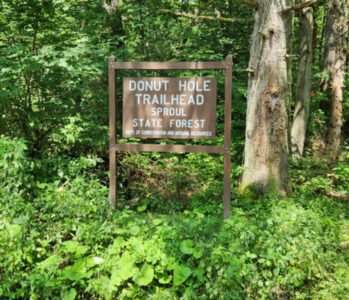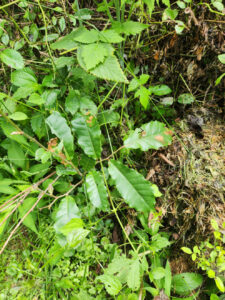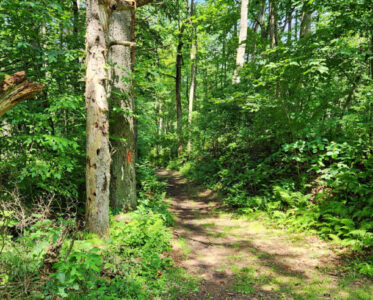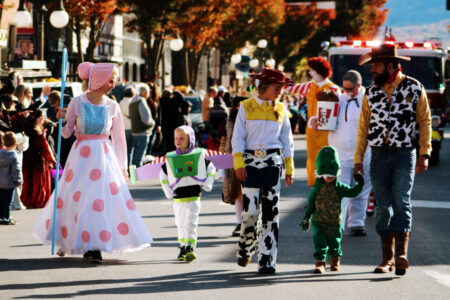Bob’s Path: Local resident does his part in preservation of trail
- PHOTO PROVIDED The sign indicating the Donut Hole Trailhead is pictured above.
- PHOTO PROVIDED A chestnut tree sapling can be seen nestled amongst other foliage along the Donut Hole Trail near Farrandsville.
- PHOTO PROVIDED A portion of the Donut Hole Trail in Farrandsville is pictured above. Local resident Bob Simcox has been working in the area of this trail to revitalize the chestnut trees that were previously wiped out.
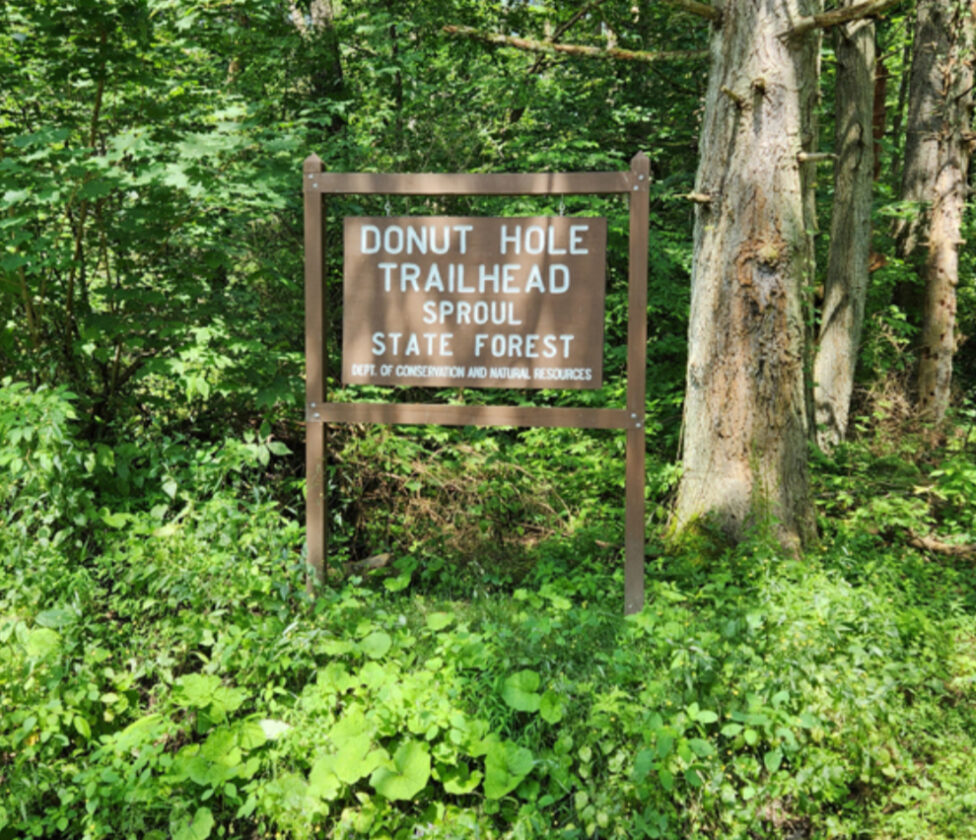
PHOTO PROVIDED The sign indicating the Donut Hole Trailhead is pictured above.
FARRANDSVILLE — It all started back about 70 years ago, when Bob Simcox was five.
At that time his family lived in Farrandsville a little over a mile from the Donut Hole trailhead. On this particular day, his older brother had left the house to meet up with friends at the trailhead, and Bob didn’t like being left behind. So he trudged up the road to find the other boys. By the time he caught up with them, they’d found a porcupine.
As Bob remembers it, the Game Warden arrived and all of them — except Bob — drove off in the warden’s truck, leaving him alone. So he turned around and walked back home.
The problem was: he hadn’t informed the babysitter he was leaving the house.
She was furious when he arrived back home. He got a beating that he still remembers. But the beating didn’t really matter. What proved more important was the fact that this day, and his wayward adventure, would mark the beginning of a productive, life-long journey.
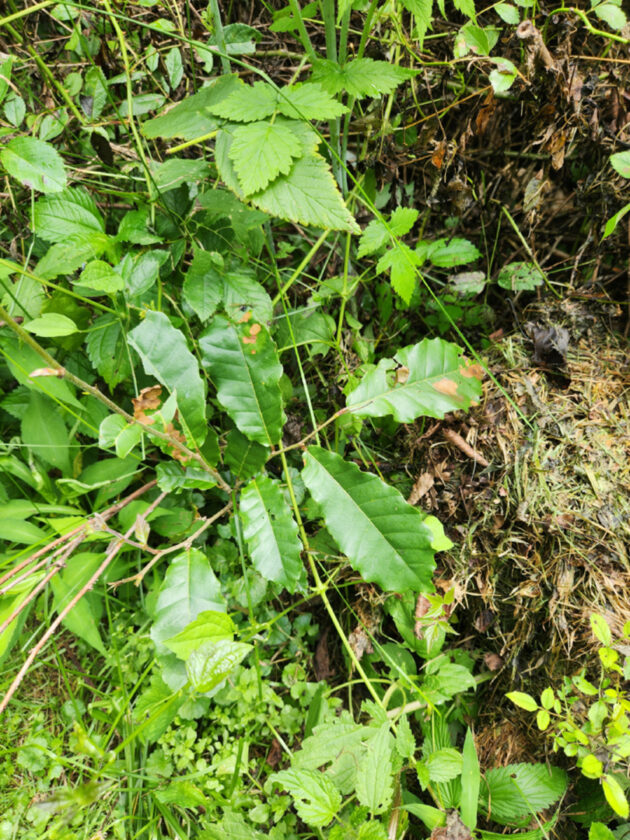
PHOTO PROVIDED A chestnut tree sapling can be seen nestled amongst other foliage along the Donut Hole Trail near Farrandsville.
Bob’s own history intersects that of the trail at several points.
In the 1800s Pennsylvania’s forests were being harvested to provide wood for construction and charcoal for the iron furnaces (although the Farrandsville iron furnace burned coal).
At this time, the trail became a logging road, allowing trees that had been felled in remote locations to be transported out to market and helping, in its own way, to make at least some folks in Pennsylvania rich.
Once the logging boom was over, as oil replaced wood for fuel, the road was abandoned and fell into disrepair. Along the way, a pipeline — built to carry oil from Titusville (where the first well had been drilled in 1859) down through Montoursville — burst as it crossed under Lick Run near Farrandsville and killed all wildlife in and around the stream.
The Farrandsville CCC camp was located there between 1933 and 1941, but once the camp was closed, the area remained in a desolate state for several years.
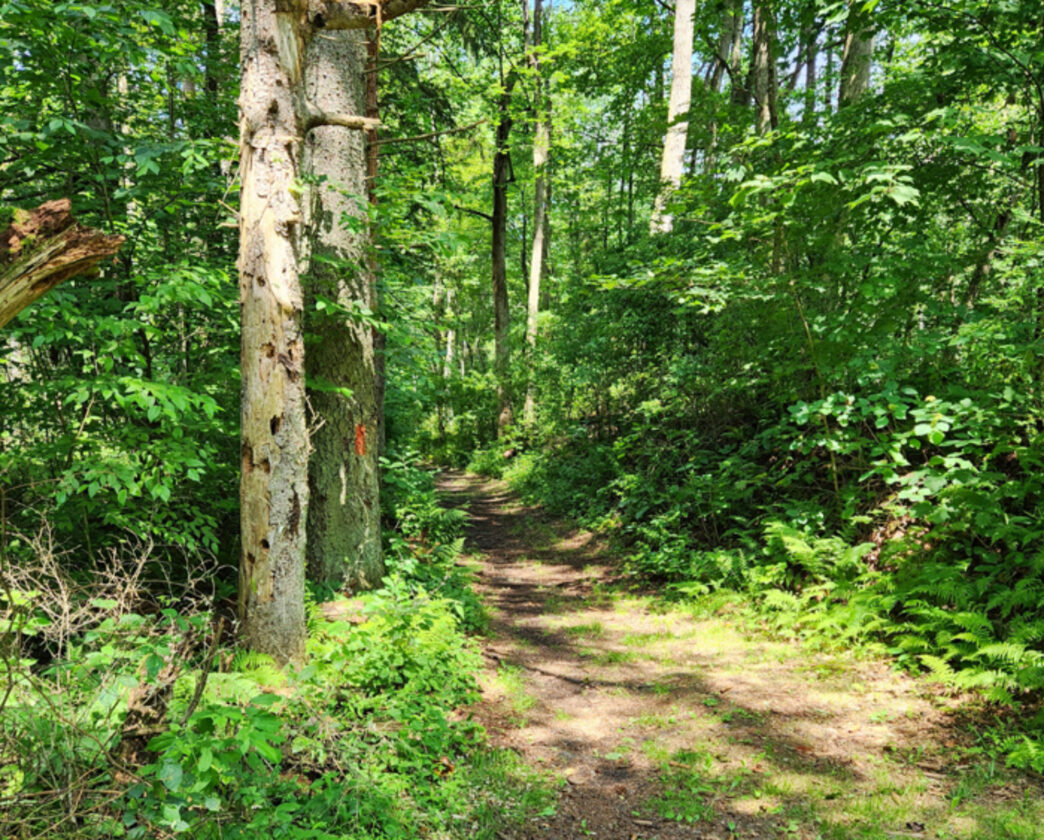
PHOTO PROVIDED A portion of the Donut Hole Trail in Farrandsville is pictured above. Local resident Bob Simcox has been working in the area of this trail to revitalize the chestnut trees that were previously wiped out.
Then, in 1958, things began to turn around. As part of a restoration project, the boy scouts came in to rebuild the road to allow the fish truck through.
Bob remembers skipping school in 1959 to ride the fish truck with the crew to help restore Lick Run. These efforts produced a body of water that now supports an abundance of life. Lick Run has been named a “High Gradient Clearwater Stream designated as Exceptional Value” by the Pennsylvania DEP. The run is also called a “Scenic River” by the DEP’s Scenic Rivers Program, and is the only waterway in Clinton County to be given that designation.
The trail itself, however, continued to go downhill.
Bob left the area for a couple of decades, working construction across the country.
In 1995 he came back and quickly realized the trail was in bad shape. Feeling he’d returned to his proper home, he bought an axe and, very slowly, began working to reopen it.
As the trail gradually began to widen, with the help of bicycle riders equipped with chainsaws, he was able to build several bridges on the lower trail, making the area even more accessible. Soon people from the Game Commission began hiking in, and about seven or eight years ago they gave him a permit which allows him motor vehicle access.
It was around this time that he decided to take up again a project he’d begun back in 1988 of planting chestnut trees.
The story of the American chestnut is a story of tremendous loss. At one time, due to its fostering by Native Americans, the chestnut represented 25 percent of all trees in Appalachia. They could grow 130 feet tall, with diameters of 14 feet, and could live up to 800 years. Their nuts provided food for humans and animals, their leaves and bark had useful medicinal properties, and their wood — both beautiful and durable — provided timber for homes, barns, fences, bridges, furniture, railroad ties and musical instruments. The chestnut was used as firewood, and its bark was critical in the process of tanning leather. At one time it was called the King of the Forest and was considered the most important tree in Appalachia.
Locally, we can see remnants of this reality in one of our place names. The tree’s scientific name, Castanea, was given to the township to honor the magnificent stand of chestnut trees in its midst.
By 1950, all four billion chestnut trees in America had virtually disappeared. What happened?
In 1870, an Asian chestnut was imported to New York City, carrying a surprise blight against which the American chestnut had no defense.
By 1904, the 700-year-old trees at the Bronx Zoo began developing cankers, and by 1911 — as the blight spread — all the American chestnuts in Pennsylvania had died, signalling, many believed, the end of the pioneer lifestyle.
We need chestnut trees, however, and Bob decided to do his part, filling his pockets with chestnuts and planting them as he walked. He believes he has planted thousands over the past 30 years.
A stroll along the trailhead path reveals many of his plantings, at all stages of growth. These are Asian chestnuts, of course, but Bob is optimistic that the American variety could stage a come-back. He’s keeping a close eye on reports from the American Chestnut Foundation as it works in partnership with scientists at major universities and research organizations to identify promising genetic material that could provide defense against the blight.
The research is complex and often slow-going, but several promising experiments are underway in what the foundation calls “an unprecedented rescue mission to return the iconic American chestnut to its native range.”
Meanwhile, Bob — now living within a stone’s throw of the Donut Hole trailhead — tends on a daily basis what has come to be called “Bob’s Path,” the first four to six miles from the trail’s entrance. He insists it’s the folks in the PA Trails Association who are the real heroes, giving their time, money and dedication to maintain thousands of trail miles, including the over 94 miles of the Donut Hole. He says he thoroughly enjoys the work but he takes even more delight in the fact that his contribution allows people access to a trail they often say is the most beautiful trail they’ve seen.
It’s clear that, although he claims modestly to be doing only “a tiny piece” of the work, the trail’s allure, which he could sense at the young age of five, is still alive, still calling out to him for protection and for new life.

